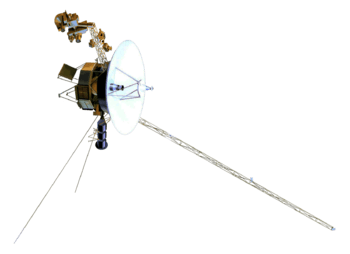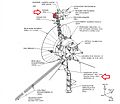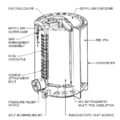Voyager 2 facts for kids

Model of the Voyager spacecraft design
|
|
| Mission type | Planetary exploration |
|---|---|
| Operator | NASA / JPL |
| Mission duration | 47 years, 8 months and 7 days elapsed Planetary mission: 12 years, 1 month, 12 days Interstellar mission: 35 years, 6 months and 25 days elapsed (continuing) |
| Spacecraft properties | |
| Manufacturer | Jet Propulsion Laboratory |
| Launch mass | 825.5 kilograms (1,820 lb) |
| Power | 470 watts (at launch) |
| Start of mission | |
| Launch date | August 20, 1977, 14:29:00 UTC |
| Rocket | Titan IIIE |
| Launch site | Cape Canaveral LC-41 |
| Flyby of Jupiter | |
| Closest approach | July 9, 1979, 22:29:00 UTC |
| Distance | 570,000 kilometers (350,000 mi) |
| Flyby of Saturn | |
| Closest approach | August 26, 1981, 03:24:05 UTC |
| Distance | 101,000 km (63,000 mi) |
| Flyby of Uranus | |
| Closest approach | January 24, 1986, 17:59:47 UTC |
| Distance | 81,500 km (50,600 mi) |
| Flyby of Neptune | |
| Closest approach | August 25, 1989, 03:56:36 UTC |
| Distance | 4,951 km (3,076 mi) |
|
Flagship
|
|
Voyager 2 is a spacecraft used by NASA to explore Jupiter, Saturn, Uranus, and Neptune. It is the only spacecraft that has come near to Uranus and Neptune. Because of this, a majority of pictures we see of these two ice planets came from this spacecraft. It was identical in form to its sister ship, Voyager 1. The probe is currently moving away from the solar system, and is heading out into interstellar space.
Voyager 2 was launched on August 20, 1977.
Both Voyager 1 and Voyager 2 include the Voyager Golden Record, which is a recording of sounds and images of life on Earth. It was designed by a team headed by Carl Sagan to communicate with extraterrestrial life.
In 2018, NASA announced that Voyager 2 had reached the heliopause on 5 November of that year.
Related pages
Images for kids
-
NASA map showing trajectories of the Pioneer 10, Pioneer 11, Voyager 1, and Voyager 2 spacecraft.
-
The current position of Voyager 2 as of December 2018. Note the vast distances condensed into an exponential scale: Earth is one astronomical unit (AU) from the Sun; Saturn is at 10 AU, and the heliopause is at around 120 AU. Neptune is 30.1 AU from the Sun; thus the edge of interstellar space is around four times as far from the Sun as the last planet.
See also
 In Spanish: Voyager 2 para niños
In Spanish: Voyager 2 para niños








